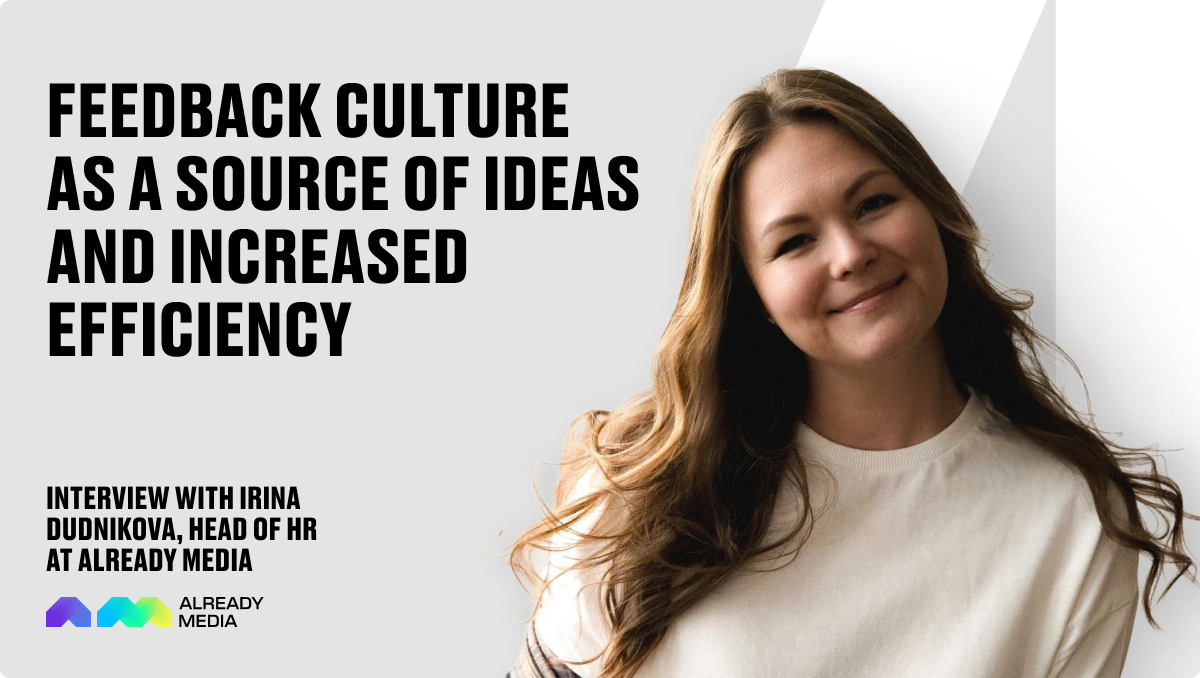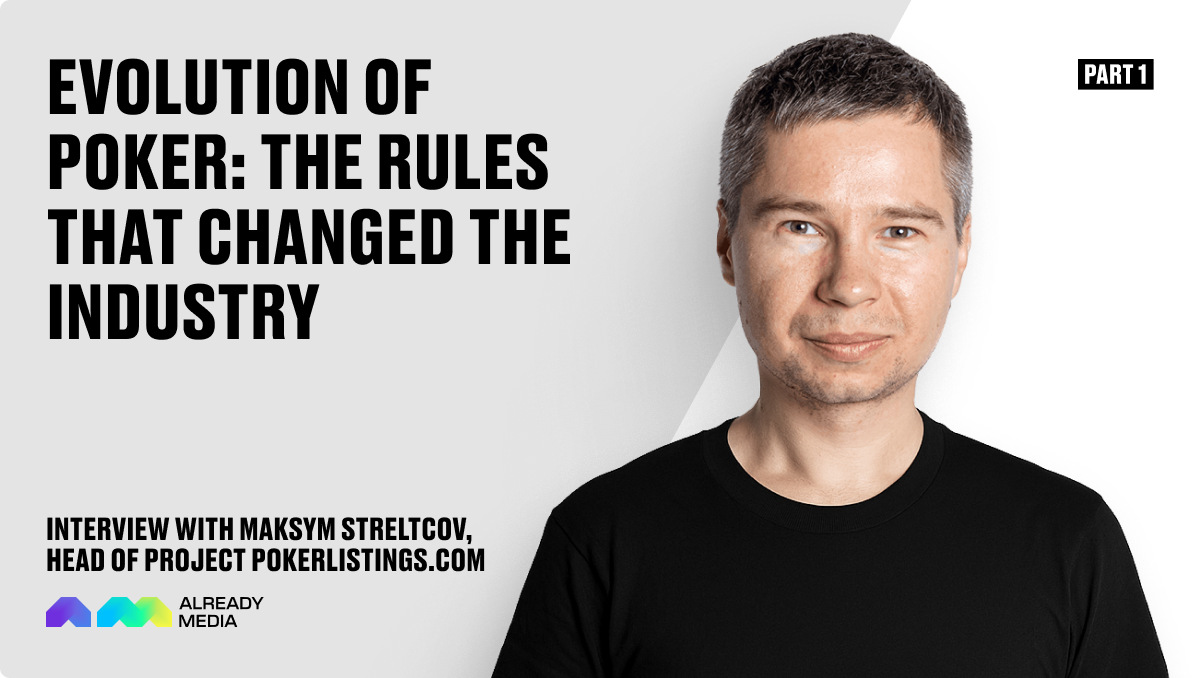
In a company experiencing rapid growth, with diverse team structures and busy schedules, feedback stops being an “informal option” and becomes a strategic management tool. In this interview, Head of HR of Already Media, Irina Dudnikova, explains how this culture is built inside the company from detailed onboarding and regular 1:1 meetings to eNPS surveys and flexible communication channels.
Hi Irina, in previous interviews you talked about how important it is to create comfortable working conditions and a healthy ecosystem within the company. Today, we’d like to focus on another important aspect: the culture of feedback. Why, in your view, has feedback become such an essential element of Already Media corporate environment?
In the culture of small teams, feedback is usually shared personally and informally. That was true for us as well. But starting in 2023, with rapid growth and scaling, team expansion, and an increase in the number of projects. There was less time left for that “informal feedback,” even though we tried hard to maintain it. The team plunged into a wave of exciting projects, many new colleagues joined, and due to heavy workloads, communication often shifted to a “task–correction–approval” format, which naturally impacted the quality of our interactions.
Considering relocations, distributed teams, and remote work with employees in over 20 countries, it was only natural that personal communication turned into chats and calls—which is normal for our stage of development and our pace. Building a high-quality feedback system is now our daily, detailed work at all levels. Feedback has become such an important element of our corporate culture because it’s how we truly hear each other, address issues in time, and give every employee the opportunity to influence the company’s culture.
Let’s start with the first stage of joining the company — onboarding. What kinds of meetings do you hold with newcomers, and how often? What channels or formats do you use?
I’d actually start even earlier—with our recruitment and pre-boarding communications. Even during hiring, most candidates note the incredible speed of our feedback, the depth of responses, and our friendly communication. Our recruitment team are true masters of maintaining relationships and providing quality feedback before, during, and after every interaction with our hiring process at Already Media. Once an offer is accepted, a candidate becomes a future employee—a newcomer.
During onboarding, we collect a lot of feedback through different steps. Its consider this steps: first day, first week, second week, months 1 and 2, probation period completion, 6 months, and so on. That’s just on the HR side. Our mentors and leads also run their own feedback system around work processes and stay in close contact with newcomers. We don’t just give feedback — we actively request it from all sides: from mentors and leads, as well as from the employee. This way, during the probation period, we can understand whether we’re a good match, agree on the best way to work together, and align expectations. Minimal turnover during onboarding confirms that we really do have an effective feedback culture in place.
What role do one-to-one meetings play in the adaptation of newcomers? Do you have a checklist of topics for these meetings?
One-to-one meetings with employees during the probation period are held several times. During these meetings, we discuss both general topics and key pain points that we can anticipate a newcomer might face during adaptation. These meetings are conducted by both the HR team and the direct manager.
We also use checklists with key topics as part of the preparation for these meetings. Thanks to this set of tools, by the end of the probation period, the employee has a comprehensive understanding of the team and what their work will look like going forward.
And what about feedback from employees who have been with the company longer? How often do you meet with them?
Since last year, we’ve implemented a system of regular 1:1 HR meetings with all employees. Many colleagues have already realized what a valuable tool it is—especially with remote work and reduced in-person interaction. Right now, we hold these meetings with every employee once every six months. This helps HR understand the overall state of the employee during times of change, and it allows us to address current issues, whether they’re about the work itself or the team environment.
We always aim for honest communication in these meetings, doing everything we can to clarify any issues and avoid leaving unresolved questions. Another benefit of this feedback approach is keeping people informed about current changes and new opportunities within the team. Since we strive to maintain a unified information space in the company. After carefully analyzing feedback each quarter, we identify key improvement points to work on.
Do you conduct performance reviews? If so, on what schedule? How is the system set up in the company?
We started implementing performance reviews in different teams in 2024. We began with the infrastructure and development teams and are now rolling them out to the SEO teams as well. Since each of our teams is unique, we’ve developed a general framework but customize the process for each unit individually. Typically, reviews are held once a year.
In a previous interview you mentioned that your employee eNPS is over 80. Could you explain what eNPS is and why it matters?
eNPS (Employee Net Promoter Score) measures employee loyalty to the company. It’s based on how likely employees are to recommend their company as a workplace, on a scale from -100 to +100. The survey is always anonymous so people can speak honestly. Our high eNPS score is no accident. We consistently listen to and hear our team at all levels, we work extensively with feedback, aim to be flexible, adapt quickly to internal and external changes, and always keep our finger on the pulse. The team is everything to us, and it absolutely deserves to have a voice.
What happens after you receive the eNPS results? Are there follow-up actions or communication with teams?
After running the anonymous eNPS survey, we compile a detailed report with recommendations for the board, unit leaders, and the infrastructure team, highlighting key improvement points. We then divide responsibilities by department with the operations team, gather critical comments from the team, and plan work on these growth areas for the next 2–3 quarters. We also make sure to share positive feedback with managers—it’s hugely motivating.
Since our last eNPS survey, we’ve identified and resolved a large number of “blind spots” and backlog issues that needed to be addressed. If something doesn’t work out as planned, we’re not afraid to share that openly with the team. Before the next survey, we plan to highlight a set of key issues we’ve resolved so the team can see our progress. And of course, we hope to achieve an even higher score this year.
What other feedback formats do you use besides reviews and eNPS? Do you use focus groups, retrospectives, anonymous forms, idea boards?
At the moment, we use practically every communication channel available and don’t miss a single opportunity to gather feedback. That includes eNPS, 1:1 meetings, reviews, regular post-event surveys, focus groups, retrospectives, anonymous forms, idea boards, and brainstorming sessions.
Finally, how would you assess the impact of feedback culture on business results overall?
Thanks to timely, high-quality feedback, we gain countless new ideas, the ability to influence internal processes and overall team results, help the team grow and develop, create better products, evaluate the impact of changes, and align business interests with those of the team. This is incredibly important and directly improves overall business outcomes.I consider the exchange of feedback one of the most powerful tools in working with a team.
Building a mature feedback culture takes time, attention, and continuous effort. At Already Media, this approach has become part of the company’s DNA a tool that unites business and team interests, identifies growth areas, and sparks new ideas. As Irina Dudnikova emphasizes, timely and honest dialogue gives every employee the opportunity to influence processes and shape an environment where the team doesn’t just get tasks done but creates quality products and achieves ambitious goals together.

